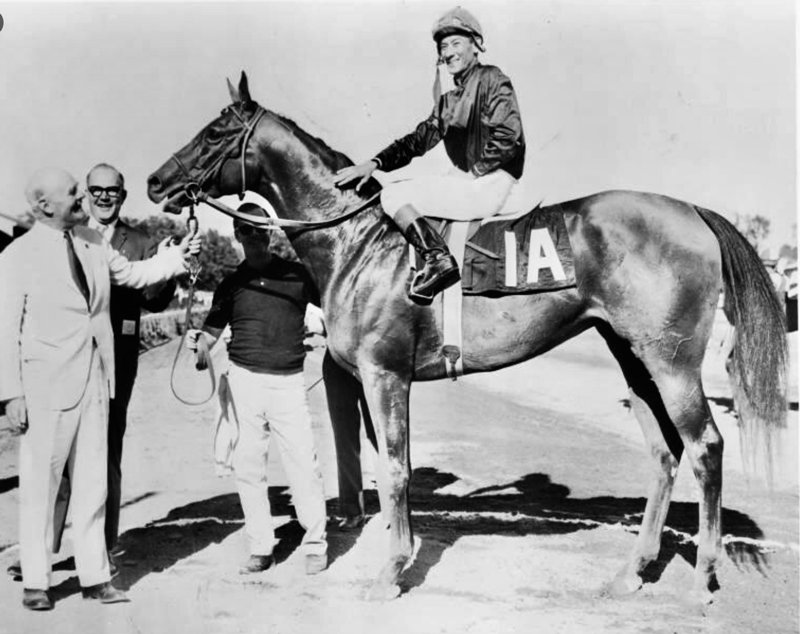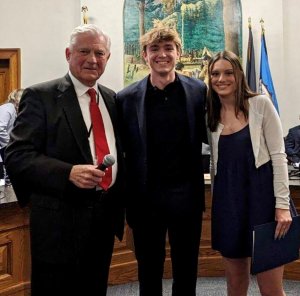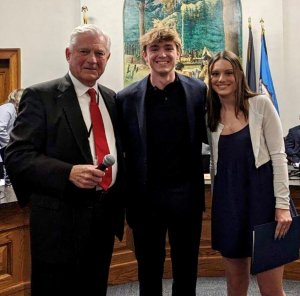In the horse racing industry, the dream of a championship quality racehorse is the single most desired outcome for breeders and owners of thoroughbreds. Millions of dollars are spent each year to combine the bloodlines of the best sires and broodmares to achieve that goal.
The science is not an exact one. The mating of two richly bred thoroughbreds does not necessarily guarantee a superior horse. It does however greatly increase the probability of success.
The perfect breeding storm took place in the Spring of 1963 when a foal was born at Seth A. “Bull” Hancock’s Claiborne Farm in Paris, Kentucky. His sire Tom Fool was the American Horse of the Year in 1953. He was unbeatable in that campaign taking all ten of his starts.
At the time, the most difficult feat in the sport was sweeping what was then known as the “Handicap Triple.” The first leg was the Metropolitan Handicap at a flat mile. Then two grueling tests of stamina followed. They included the Suburban and Brooklyn Handicaps both covering the distance of a mile and a quarter. The four-year-old became only the second horse in the sports history to take the series. He showcased his greatness in the final leg when he took the Brooklyn wire to wire under jockey Ted Atkinson carrying an eye popping 136 pounds of weight.
On the dam side was the highly talented race mare Busanda. She shared the blood of her sire War Admiral and her grandsire the immortal Man o’ War. Busanda proved her race mettle when she took on the best horses in the country taking the Suburban Handicap in 1951. The combination of the two great bloodlines had just produced a perfect specimen.
The foal was given the name Buckpasser. He was owned and bred by Ogden Phipps. Mr. Phipps stands along with William Woodward, Alfred G. Vanderbilt, Jock and C.V. Whitney, and George D. Widener as a Giant in the Horse Racing world when it lived up to its title as “The Sport of Kings.”
Buckpasser’s career started off with little fanfare. On a spring day in 1965, the two-year-old raced greenly in his debut finishing a lackluster fourth. Sixteen days later he found the winners circle at Aqueduct with an easy score. From that day on he was virtually unbeatable in his rookie campaign.
Wearing Ogden Phipps black with cherry red cap silks, the great Panamanian Braulio Baeza guided the handsome bay colt to one victory after another. Buckpasser took home the lion’s share of the major two-year-old events. They included the Hopeful Stakes here at the Spa. Then he added the world’s richest race, The Arlington-Washington Futurity, and New York’s premier event for two-year old’s, the Champagne Stakes to his ever-growing resume.
After the losing effort in his first start, Buckpasser reeled off ten of his next eleven starts. He stood tall as the best two-year-old in the Country. He was so good that The Triple Crown of 1966 seemed a foregone conclusion. He opened his three-year-old season with an exhibition race at Miami’s “Winter Palace”, Hialeah Park. Also entered was his speedball stablemate Impressive. His name speaks to exactly what he was that day. He shocked racing fans across the country when he took the measure of Buckpasser, easily besting him.
Buckpasser was back on his game nine days later when he tallied in the Everglades Stakes. Next up was Hialeah’s major Kentucky Derby prep, the Flamingo Stakes. In a decision that caused an uproar from track patrons, management decided to not allow wagering on the big event. They knew that there would be a minus pool that would cause a loss of revenue for the track if he placed in the money. Buckpasser got the nod in a thriller over Abe’s Hope. The race took on a life of its own when it became known as “The Chicken Flamingo” in response to Hialeah’s frugality. Buckpasser was steamrolling towards Churchill Downs and “A Run for The Roses.” Then fate intervened. Only days after the Flamingo, he suffered a quarter crack on his right front hoof. Ogden Phipps’ dream of a Triple Crown was shattered. The healing would be a slow process. The big horse was out of action for three months. He was about to come back with a vengeance.
On a warm June day, he returned to the races. Phipps and his outstanding trainer Eddie Neloy decided to resume his three-year-old campaign at Delaware Park. There he took the Leonard Richards Stakes by a slim margin. For the rest of 1966 Buckpasser was a one-horse show. He ran the table in the most important races on the American Turf. He headed out to Chicago, where he easily took what was known as “The Mid America Triple” at Arlington Park.
In the first leg of the series he put on a performance for the ages. His stablemate Impressive set a blistering pace, lighting the tele-timer with an unheard of 1:06.4 seconds at the six-furlong mark. Buckpasser then blew by him. When he hit the finish line, he took ownership of the world’s record for a mile. He had just covered the distance in 1:32.3, demolishing the standard set by the great Swaps ten years earlier. He was now a very big star. The best was yet to come.
It was back home to New York and the big time. Buckpasser wowed a massive crowd when he charged down the stretch to take the Brooklyn Handicap at Aqueduct. Next up it was Saratoga and the coveted Travers Stakes. After taking the Spa’s main event he was back on Long Island for the Fall Classic races, The Woodward Stakes and The Jockey Club Gold Cup. You can add those to an almost flawless campaign. He was crowned Horse of the Year for 1966. Buckpasser had entered horse racing royalty. Eddie Neloy decided to take the champ out to California and Santa Anita to contest the West Coast’s lucrative winter handicap series. He continued his winning ways, taking the Malibu Stakes on the last day of 1966. Three weeks later he opened his third season with a victory in the San Fernando Stakes. The quarter crack issue flared up again and the champ was sidelined again for the next four months.
Back east he began preparations to contest New York’s “Handicap Triple.” With greatness came weight. Buckpasser would be no exception. He got his first taste of 130 pounds in the Metropolitan Mile. He shrugged off the heavy load and took his fifteenth consecutive race.
Ogden Phipps seriously considered taking Buckpasser to the Prix de l’Arc de Triomphe on the grass at Longchamp. He had never raced on the turf. Eddie Neloy decided to test his skills on that surface in the Bowling Green Handicap at Aqueduct. Not only was Buckpasser weighted with 135 pounds, he was wearing racing plates that were required to be worn on grass courses in France.
Buckpasser didn’t care for any of it. He was a well beaten third. Jockey Braulio Baeza said it best.” Buckpasser got beat by the shoes, the grass and the weight.” The trip to Paris was off.
He was next pointed for the Suburban Handicap at Aqueduct. Tommy Trotter, the track’s Racing Secretary assigned him 133 pounds for the race. Buckpasser wowed the fans with a breathtaking performance. In deep stretch the champ found himself two lengths behind. He looked hopelessly beaten. Digging in with massive strides, he drove past the leader Ring Twice and hit the wire a half-length winner.
Buckpasser needed one more to join his sire Tom Fool, Whisk Broom II, and the great Kelso as winners of the elusive “Handicap Triple.” This time he would have to carry 136 pounds over the mile and a quarter of the Brooklyn Handicap to get it done. The champ for one of the few times in his career was second best. He was soundly beaten by Handsome Boy, a very good horse being spotted twenty pounds.
1967 had been the year of Dr. Fager and Damascus. The two three-year-olds had made headlines on sports pages all over the country for their exploits on the racetrack. It was inevitable that they would meet with Buckpasser to decide Horse of The Year honors. The three warriors were entered in the Woodward Stakes. The event was being lauded as “The Race of the Century.” The champ had not raced in three months due to nagging injuries. When the field walked onto the track for the main event, Buckpasser was a slight favorite over his illustrious opponents. The big bay just wasn’t up to the task. The long hard campaigns and health issues had caught up to him. On the other hand, the great Damascus was at the top of his game. He galloped home ten lengths clear of the field. Buckpasser passed a tiring Dr. Fager to take second place. Buckpasser’s phenomenal career was over. He collected one final prize. He was named Male Handicap Horse of the Year for 1967. The big bay won championship honors in all three of his racing seasons. He had compiled a superb lifetime record of 25 wins in 31 starts. Nothing ever looked easy for the champ. He had the habit of pulling up when he took the lead. This was the reason why his victory margins were so slim. Most of his winning races were decided by no more than two lengths, averaging out to just a about a length.
Buckpasser is renowned for his flawless confirmation. New York Racing Association Veterinarian Manny Gilman, who saw them all, had this to say about Buckpasser. “Every horse has just about a hundred faults of confirmation. I would defy anybody to pick a flaw in Buckpasser.” Richard Stone Reeves, the most important painter of thoroughbred horses in the latter half of the Twentieth Century added this comment. “Buckpasser is the most perfectly proportioned Thoroughbred I have seen.” Buckpasser did not have to wait long to take his rightful place in the Sport’s Hall of Fame here on Union Avenue. His plaque was unveiled in 1970, a short three years after his retirement.
He was a product of proven bloodlines. The combination of Tom Fool and Busanda had more than done their job. They had created a masterpiece of confirmation and racing ability of epic proportions, the immortal Buckpasser.
A final note: With Breeder’s Cup on tap for this weekend, it’s a good time to take a look at Buckpasser’s prowess in the breeding shed. He was a winner there too. The big bay sired a total of five Champions. They include the likes of Numbered Account, Relaxing, La Preveyonte, L’ Enjouler, and Northcliffe. Buckpasser’s Royal blood continues to enhance the breed. His offspring have marked the world’s racing scene with championship quality thoroughbreds for over a half a century.







































